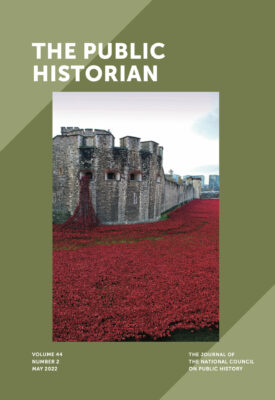Editor’s Corner: War and Memory
18 May 2022 – Sarah H. Case
Editors’ Note: We publish the editor’s introduction to the May 2022 issue of The Public Historian here. The entire issue is available online to National Council on Public History members and to others with subscription access.
As Timothy Snyder, historian of Ukraine, reminds us, the myths, memories, and stories about a nation’s past shape its understanding of the present and the future. Further, public memory can obscure the complexities of history; as he writes, “there is a difference between memory, the impressions we are given, and history, the connections that we work to make—if we wish.”[1] This insight—that mythic public memory can both create a deceptive understanding of history and have serious and often violent consequences in the present—is something that public historians have long understood. Lost causes and mythic beliefs continue to haunt us.

The cover of May 2022 Issue of “The Public Historian” features “Blood Swept Lands and Seas of Red” installation at the Tower of London, commemorating the centenary of WWI in the UK. Lucy Noakes and James Wallis examine the public history of the anniversary in this issue in “The People’s Centenary? Public History, Remembering, and Forgetting in Britain’s First World War Centenary.” Image Photo credit: Andy Evans Photo
War, conflict, and memory are central to the contributions in our current issue. In “Memorializing Conflict and History in South Thailand through Museum, Art and Poetry,” Mala Rajo Sathian makes the case for centering artists as creators of counter-histories. Sathian argues that the sometimes-violent conflict between the Malay Muslim minorities of southern Thailand (known as the Deep South) and Thai government is presented in official histories (including textbooks and museums) from the viewpoint of the state. Private and local museums, often those commemorating figures in the arts, offer an alternative understanding of the conflict through creating a “collected public history of a restive region as presented through the arts, which has helped create increased visibility for the region.”
Our first Report from the Field, Stephan Fender’s “The Squat-Museum: Public Urban History in Autonomous Spaces: The Hamburger Gängeviertel,” also engages with public art and public history, and examines a collaboration, still rare in Germany, between university students, professional historians, and community members. The historic Gängeviertel, central to working-class and Bohemian cultures in Hamburg, Germany, was long-neglected in official accounts of the city as prosperous and business-oriented. Although much of the neighborhood has been torn down to make way for office buildings, in 2009 antigentification activists and artists occupied surviving structures and created a self-governing, cooperative community. Fender worked with undergraduate students and residents to create an onsite, interactive museum interpreting the rich history of the neighborhood and the founding of the present community. The result demonstrates that, in Fender’s words, “student and public participation can significantly improve the development of small-scale public history projects and contribute to the blurring of the border between academia and the public.”
Lucy Noakes and James Wallis return to public memory and war in “The People’s Centenary? Public History, Remembering and Forgetting in Britain’s First World War Centenary.” Examining the thousands of projects that marked the centenary of the First World War, both nationally and locally sponsored, they found that overwhelmingly, a narrative that emphasized the experience of the Western Front soldier and viewed the war as tragic and futile shaped the commemoration of the war. Although this understanding of the war as individual tragedy did inspire many in Britain to become active in researching the experience of their family or community members, this affective, personal perspective of the conflict also served to obscure its wider significance and the experience of people other than young, white, male soldiers.
In “Making Public Memory: The Public History of the Spanish Civil War and the Francoist Dictatorship in the Basque Country (1936–2015),” Unai Belaustegi and Xabier Irujo consider how public history organizations “investigate, (re)interpret, and publicize the historical events of the Spanish Civil War (1936–39) and the subsequent dictatorship of Francisco Franco (1939–75).” Similar to Sathian’s findings in Thailand, local, grassroots organizations in the Basque Country have created public histories in regional communities long viewed as problems by the central state. They have offered an alternative understanding to what Belaustegi identifies as official “indifference” to Franco-era violence in Basque Country.
A final report from the field, coauthored by public historian and curator Adina Jocelyn Langer and Sandra Kollen Ghizoni, research specialist at the Federal Reserve Bank of Atlanta, examines a time of violence to learn lessons about survival. Langer and Ghizoni together conducted oral history interviews with Holocaust survivors in the Atlanta area that focused specifically on questions of how people build economic systems in traumatic situations. As they argue, “Much can likely be learned from these extreme economic conditions that could have value for present and future situations, including those affecting people currently displaced from their normal economic environment due to war, persecution, or natural disaster, all of whom who are trying to build up their economic lives after leaving most of their assets and livelihoods behind.” Their interviews with survivors also sought to open up conversations that moved beyond the practiced stories long told to schoolchildren and other groups, to enhance “meaningful interaction and new insights in the co-creation of oral history.”
Together, these articles underline the importance of determining the distinction between myth and history, and the complex ways each shape our understanding of the present.
~Sarah H. Case, the editor of The Public Historian, earned her MA and Ph.D. in history at the University of California, Santa Barbara, where she is a continuing lecturer in history, teaching courses in public history, women’s history, and history of the South. She is the author of Leaders of Their Race: Educating Black and White Women in the New South (Illinois, 2017) and articles on women and education, reform, and commemoration.
[1] Timothy Snyder, Road to Unfreedom: Russia, Europe, America (New York: Tim Duggan Books, 2018), 9.



